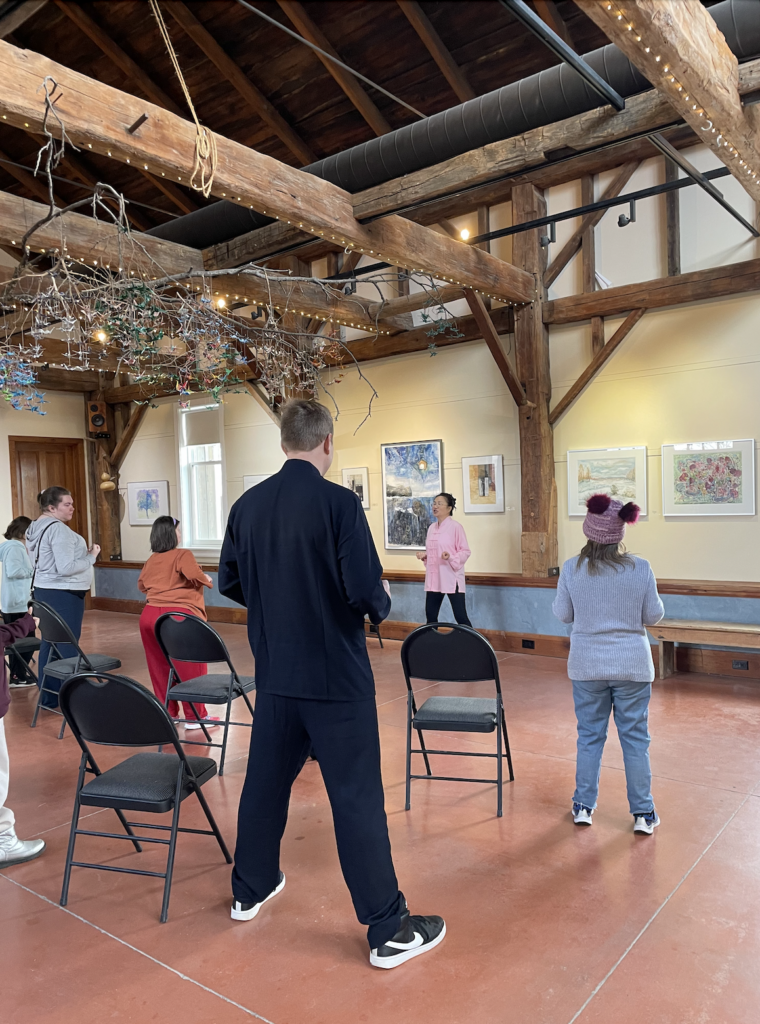Listen to the full story here:
Inclusivity amongst the diverse disabled community is a topic that is garnering attention in Canadian news. With the new Canadian federal budget set to drop on April 16, disability resources are expected to be part of it and the benefit is supported by the community according to the Angus Reid Institute. Meanwhile, the larger Canadian community continues to support accessibility in many ways.
Two Toronto martial arts programs are proving that accessibility has many paths. Leaders at both Joshua Creek Heritage Art Centre and Alborz Taekwondo Academy say that accessibility should be a necessity when it comes to martial arts.
Joshua Creek Heritage Art Centre focuses its martial arts on countless paths including Tai Chi and Qigong, while Alborz Taekwondo Academy focuses its teachings on Taekwondo. Lead Assistant Instructor, Tina Henderson has been training at the academy for 28 years and is a fourth-degree black belt in Taekwondo.
When she started at the academy, she was the only woman in the adult class and found the program lacked diversity and inclusivity.
She asked herself, “What causes people of other abilities to be interested in martial arts? And how can we integrate that into our program on top of the good fitness and martial arts training?”
She shares that this specific integration has been the biggest evolution they’ve seen in 30 years of training.

Initially, she had parents approach her wanting their child to participate in the class but feeling hesitant due to the child’s disability. Henderson researched and focused her teachings on highlighting and modifying training to be accessible to all children. Although there was a lot of trial and error, Henderson says she was dedicated to facilitating a program that worked for everyone.
TMU Canada Excellence Research Chair in Health Equity and Community Wellbeing and Professor of the School of Disability Studies Karen Soldatic, says that integration isn’t always the best term for accessibility and the focus should be on inclusion, diversity and equity.
“We’re thinking about the ways in which social structures require to change, move, become flexible to enable people with disabilities to participate in a culturally, socially, respectful and engaging facility.”
Soldatic says that in disability studies, the IDEA model is often the main focus when it comes to understanding the importance of inclusivity. When broken down, this model is Inclusion, Diversity, Equity and Accessibility. People with disabilities can’t just be deemed in a singular group and many things must be taken into consideration when considering accessibility. These vary from cognitive, physical and sensory attributes to ethnic considerations and the backgrounds of individuals.
“It is a complex identity formation and is positioned within social structures differently depending on the person’s identity, as it intersects with other social structures in their world.”
Unlike Joshua Creek, Alborz Taekwondo Academy does not have separate programs for individuals with special needs. They have all students of all capabilities learn together.
“We have always had a very, very inclusive environment. As a team, we don’t leave anyone behind. Every child was included in every activity. If we had to modify, we modified, but everyone was involved,” says Henderson.
Henderson says that although at times parents were concerned about their children being involved in the program, she says that the community can learn from the children, and everyone deserves an opportunity.
Dechen Yee’s work as an instructor began in 2019, prior to this, she had been working a corporate job for 22 years and already had a deep interest in Tai Chi. She began to help with programs at Joshua Creek Heritage Art Centre and now leads the Tai Chi and Qigong for Individuals with Special Needs Program, and her students are primarily individuals with neurodivergent challenges as well as physical ones.
Yee says that Tai Chi and Qigong help with balance and mental clarity but also the ability to be more in tune with nature, “It all has to do with mindful movements and breathwork to facilitate movement and ease of change of posture without the pain, the pain is what we are trying to free ourselves from,” She says, “Whether you’re fit as a fiddle or you’re struggling with your health, physically, mentally or emotionally. It’s inclusive and accessible.”
Yee says that Tai Chi and Qigong are practiced to attain self-confidence and are a form of martial arts. She found that it created a peaceful environment and facilitated confidence in her students.
Although Tai Chi and Qigong are becoming more well-known forms of martial arts in the community, Yee hopes that everyone and anyone can reap the benefits and familiarize themselves with the practice.
Yee’s student, Anthony Liszega, is someone who attends her class every Friday and attends other programs at Joshua Creek as well.
“It’s fun to learn about and it’s fun to do the exercises. I’m always proud to be here,” says Liszega. Liszega finds interest in the self-defence aspect of the class and keeps coming back due to the improvements he’s seen in his energy and health.
Soldatic says it’s really about listening to people with disabilities and letting them decide, given the context and culture of the space they’re in, what would actually best suit them.
She says moving forward, the best support for the disabled community would be a well-resourced public policy, changing attitudes and thought through rights-based inclusion and increased accessibility literacy within mainstream society. Programs are important, but the versatile consideration of the diversity of this specific community is even more important.
“I think the biggest stereotype really is that most people with disabilities don’t have the capacity to do most things. But actually, we know that to be totally untrue. People with disabilities really contribute to society in various spheres,” says Soldatic
This article may have been created with the use of AI tools such as

